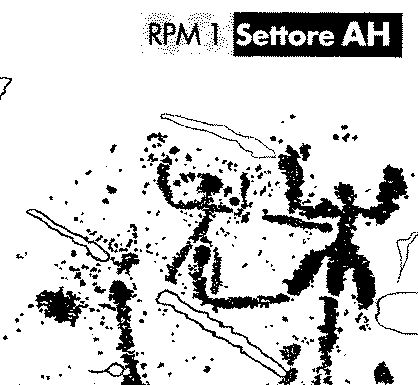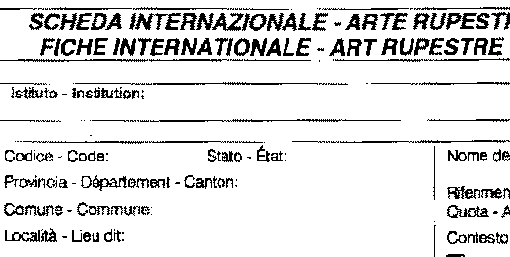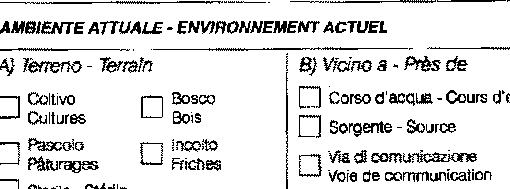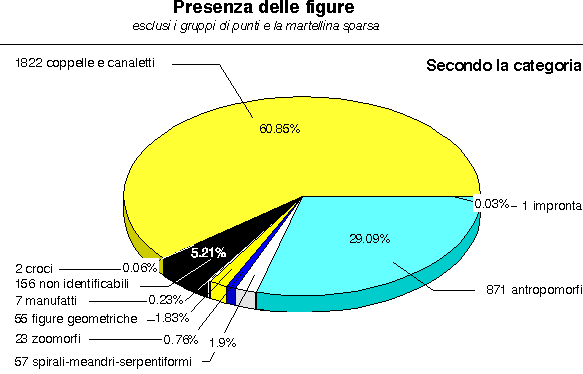

Main
History
Fields
Features
Note
Download
Rock Art Database
HISTORY. EUGA was compiled originally in 1992-1994 in order to facilitate the recording of the engravings of the Rupe Magna, in Valtellina (Italy), under a Rupestrian Archaeology research conducted by Footsteps of Man (Orme dell'Uomo) and promoted by the Grosio Park of the Engraved Rocks and by the Lombardy Archaeological Superintendency.
EUGA was preceded in 1991 by GLYPHO, a DB4 application by Gruppo Ricerche Cultura Montana (Italy), allowing to compute totals and percents of the 125 typologies of the Western Alps engravings.
In 1992-1994 on the Rupe Magna (RPM1) 5454 figures have been recorded in a *.DBF file. Related database archives (*.DBF) contain data about the rock and about each figure.

-
The rock record derives from the "International Record of Western Alps Engraved Rocks" (Scheda Internazionale di Arte Rupestre delle Alpi Occidentali).
This record was prepared by a French-Swiss-Italian board in 1988-1989.
- the Piedmont Archaeological Superintendency (Italy)
- the the Musée Savoisien de Chambery (France)
- the S.V.A.P.A. (Aoste, Italy)
- the CeSMAP of Pinerolo (Italy)
- the GRCM of Turin (Italy)
- And many rock art scholars
took part in the meetings.

- The aim was to unify the data coming from the Western Alps engraved rocks. This record, containing 90 fields, is now utilized by many scholars in order to obtain a general overview of the rock.


- The figure record derives from the "Engraved Rocks Computer Recording Model", prepared in 1988-1989 under the coordination of the Lombardy Archaeological Superintendency. It is based on a category-style classification of the Valcamonica (Italy) Rock Art.
Category is identified by a capital letter, syle by a number. Each Style corresponds to an archaeological period; style 3, for examples, is identified with Copper Age, by the daggers engraved on the rocks depicting an archaeological object.
Computing and percentage of Rupe Magna engravings have been done with EUGA, and then elaborated graphically (picture down).

- In EUGA both records have been improved, in order to add space for new typologies and for relation-superimpostion computing. It is in particular possible to add, as a "work in progress", new categories and styles.
- BALLET F. - RAFFAELLI P., 1990. Rupèstres. Roches en Savoie. Gravures, peintures, cupules, Chambery
- ARCA' A., 1991-92. Verso un archivio delle incisioni rupestri, Survey, n. 7-8, pp. 103-114
- SANTACROCE A., 1992-93. Scheda internazionale per il censimento delle incisioni rupestri nelle Alpi Occidentali, "Bulletin d'études préhistoriques et archéologiques alpines", n.s. III-IV, pp. 157-170, Aoste
- SEGLIE D. - RICCHIARDI P. - DELLERBA G. - CANDELLERO D., 1994. International form "AR-RA": Rock Art in the western Alps - International cooperation in the western Alps (Italy, France and Switzerland), "Notizie Archeologiche Bergomensi", 2, pp. 169-174
- SANTACROCE A., 1995.Scheda Internazionale per il censimento delle incisioni e delle pitture rupestri nelle Alpi occidentali, Immagini dalla Preistoria, pp. 21-25